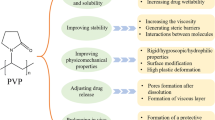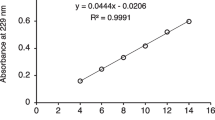Abstract
This paper investigates phosphate glasses incorporating vanadium and molybdenum oxides for effective management of dissolution and drug release. These glass formulations are found to reduce the rate of dissolution from the glass surfaces. The drug functional groups of vancomycin molecules loaded by immersion showed stronger hydrogen bonding with Vanadium doped glasses and consequently lower rate of drug release over 2 weeks indicating better surface attachment with the drug molecules and slow drug release profiles. This can be explained by the strong adherence of drug molecules to glass surfaces compared with the molybdenum containing glasses (PM5 and PM10). The strong attachment relates to hydrogen bonding between the amino-functional groups of vancomycin and the hydrated P–O–H groups in the glass network. In conclusion, the rate of dissolution of doped glasses and the rate of drug release can be administered to deliver the drug molecules over weeks.
Graphical Abstract











Similar content being viewed by others
References
El-Meliegy E, Noort RV. Glasses and glass ceramics for medical applications. London: Springer; 2012.
Baksh D, Davies JE. Design strategies for 3-dimensional in vitro bone growth in tissue-engineering scaffolds. In: Davies JE, editor. Bone engineering. Toronto: Interrobang Cgraphic Design Inc.; 2000. p. 488–95.
Ahmed I, Lewis M, Olsen I, Knowles JC. Phosphate glasses for tissue engineering: Part 2. Processing and characterisation of a ternary-based P2O5–CaO–Na2O glass fibre system. Biomaterials. 2004;25(3):501–7.
Navarro M, Clement J, Ginebra MP, Martınez S, Avila G, Planell JA. Improvement of the stability and mechanical properties of resorbable phosphate glasses by the addition of TiO2. Proceedings of the 14th international symposium on ceramics in medicine, Bioceramics 14, Palms Springs; 2002. p. 275–8.
Zhang Y, Lopes MA, Santos JD. Bioceramics. Key Eng Mater. 2000;192:643.
Uo M, Mizuno M, Kuboki Y, Makishima A, Watari F. Biomaterials. 1998;19:2277.
Drake CF, Allen WM. Biochem Soc Trans. 1985;13:516.
Bhaskar SN, Brady JM, Getter L, Grower MF, Driskell T. Oral Surg. 1971;32:336.
Burnie J, Gilchrist T, Duff SRI, Drake CF, Harding NGL, Malcom AJ. Biomaterials. 1981;2:244.
Ploska U, Berger G. Biomaterials. 1997;18(24):1671.
Knowles JC, Franks K, Abrahams I. Biomaterials. 2001;22(23):3091.
Fulmer MT, Ison IC, Hankermayer CR, Constantz BR, Ross J. Biomaterials. 2002;23(3):751.
Pickup DM, Newport RJ, Knowles JC. Sol–gel phosphate-based glass for drug delivery applications. J Biomater Appl. 2012;26(5):613–22.
Sanzana ES, Navarro M, Macule F, Suso S, Planell JA, Ginebra MP. Of the in vivo behaviour of calcium phosphate cements and glasses as bone substitutes. Acta Biomater. 2008;4(6):1924–33.
Kioseoglou E, Salifoglou A. J Agroaliment Process Technol. 2011;17:239–41.
Heyliger CE, Tahiliani AG, Mcneill JH. Science. 1985;227:1474.
Maniatakou A, Karaliota S, Mavri M, Raptopoulou CP, Terzis A, Karaliota A. J Inorg Biochem. 2009;103:859–68.
Ghauri MA, Siddiqi SA, Shah WA, Ashiq MGB, Iqbal M. Optical properties of zinc molybdenum phosphate glasses. J Non-Cryst Solids. 2009;355(50–51):2466–71.
Grzywa M, Nitek W, Lasocha W. Synthesis, characterization and crystal structures of three dinuclear diperoxo complexes of Mo(VI): K2{O[MoO(O2)2H2O]2}2H2O, (C6H8N,NH4){O[MoO(O2)2H2O]2} and (C6H8N,Na){O[MoO(O2)2H2O]2}. J Mol Struct. 2008;888(1–3):318–26.
Kokubo T, Takadama H. How useful is SBF in predicting in vivo bone bioactivity. Biomaterials. 2006;27:2907–15.
Dietzel AZ. Die Kationenfeldstärken und ihre Beziehungen zu Entglasungsvorgängen, zur Verbindungsbildung und zu den Schmelzpunkten von Silicaten. Z Elektrochem. 1942;48:9–23.
Zavalij PY, Whittingham MS. Acta Crystallogr. 1999;B55:627.
Abo-Naf SM, Ghoneim NA, El-Batal HA. J Mater Sci: Mater Electron. 2004;15:273.
Rafiqul Md. Ahsan, M. Golam Mortuza. J Non-Cryst Solids. 2005;351:2333.
ElBatal FH, Marzouk MA, Abdelghany AM. UV–visible and infrared absorption spectra of gamma irradiated V2O5-doped in sodium phosphate, lead phosphate, zinc phosphate glasses: a comparative study. J Non-Cryst Solids. 2011;357:1027–36.
Kader AA, Higazy AA, Elkholy MM. J Mater Sci: Matter Electron. 1991;2(3):157–63.
Carta D, Pickup DM, Knowles JC, Ahmed I, Smith ME, Newport RJ. A structural study of sol–gel and melt-quenched phosphate-based glasses. J Non-Cryst Solids. 2007;353:1759.
Shih PY. Properties and FTIR spectra of lead phosphate glasses for nuclear waste immobilization. Mater Chem Phys. 2003;80:299.
Pavic L, Milankovic AM, Rao PR, Santic A, Kumar VR, Veeraiah N. J Alloys Compd. 2014;604:352–62.
Abou Neel EA, Chrzanowski W, Valappil SP, O’Dell LA, Pickup DM, Smith ME, et al. Doping of a high calcium oxide metaphosphate glass with titanium dioxide. J Non-Cryst Solids. 2009;355:991.
Shaim A, Et-tabirou M. Mater Chem Phys. 2003;80:63–7.
Saout LG, Simon P, Fayon F, Blin A, Vaills Y. J Raman Spectrosc. 2002;33:740–6.
Karabulut M, Metwalli E, Day DE, Brow RK. Mossbauer and IR investigations of iron ultraphosphate glasses. J Non-Cryst Solids. 2003;328:199.
Delahaye F, Montagne L, Palavit G, Touray JC, Baillif P. Acid dissolution of sodium–calcium metaphosphate glasses. J Non-Cryst Solids. 1998;242:25–32.
Fernandez E, Gil FJ, Ginebra MP, et al. Calcium phosphate bone cements for clinical applications: Part 1. Solution chemistry. J Mater Sci: Mater Med. 1999;10:169–76.
Hench LL. Physical chemistry of glass surfaces. J Non-Cryst Solids. 1977;25:343–69.
Isard JO, Allnatt AR, Melling PJ, et al. An improved model of glass dissolution. Phys Chem Glasses. 1982;23(6):185–9.
Zhu M, Zhang J, Tao C, He X, Zhu Y. Design of mesoporous bioactive glass/hydroxyapatite composites for controllable co-delivery of chemotherapeutic drugs and proteins. Mater Lett. 2014;115:194–7.
Higuchi T. Mechanism of sustained action medication. Theoretical analysis of rate of release of solid drugs dispersed in solid matrices. J Pharm Sci. 1963;52:1145–9.
Korsmeyer RW, Gurney R, Doelker E, Buri P, Peppas NA. Mechanisms of solute release from porous hydrophilic polymers. Int J Pharm. 1983;15:25–35.
Peppas NA. Analysis of Fickian and non-Fickian drug release from polymers. Pharm Acta Helv. 1985;60:110–1.
Acknowledgments
This project is supported financially by the Science and Technology Development Fund (STDF), Egypt, Grant No: 5150.
Author information
Authors and Affiliations
Corresponding author
Rights and permissions
About this article
Cite this article
El-Meliegy, E., Farag, M.M. & Knowles, J.C. Dissolution and drug release profiles of phosphate glasses doped with high valency oxides. J Mater Sci: Mater Med 27, 108 (2016). https://doi.org/10.1007/s10856-016-5711-8
Received:
Accepted:
Published:
DOI: https://doi.org/10.1007/s10856-016-5711-8




